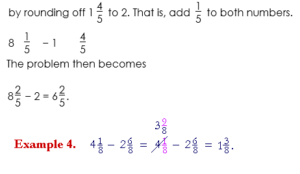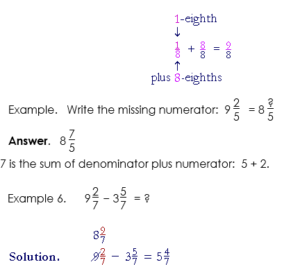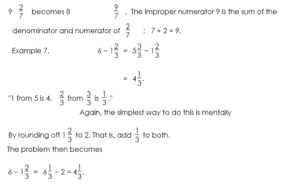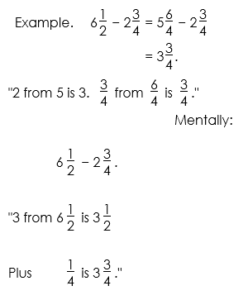Back to: Mathematics Primary 4
HELLO, WELCOME BACK TO CLASS
To add or subtract fractions, they must be converted into fractions that have a common denominator. A common denominator is a number that is evenly divisible by the denominators of all of the original fraction. (That is, the denominators of the original fractions are all factors of the common denominator). After finding a suitable common denominator, each of the fractions must be converted into a fraction that has this common denominator. To do so, multiply the numerator and denominator of each of the fractions by the same integer, so that the number obtained in the denominator will be the number that was chosen to be the common denominator. Multiplying the numerator and denominator by the same number is the same as multiplying by 1, and its value remains unchanged. Once the fractions have a common denominator, add or subtract the new numerators and reduce the resulting fractions to lowest terms where possible.
Adding Fractions with Unlike Denominators
To add fractions with unlike denominators, first rewrite them with like denominator.
Then, you know what to do! The steps are shown below.
- Find a common denominator.
- Rewrite each fraction using the common denominator.
- Now that the fractions have a common denominator, you can add the numerators.
- Simplify to lowest terms, expressing improper fractions as mixed numbers.
You can always find a common denominator by multiplying the two denominators together. See the example below
F0r example:
Solution. The lowest common multiple of 3 and 4 is their product, 12. We will convert each fraction to an equivalent fraction with denominator 12.
12 four times. Four times 2 is 8.” (In that way, we multiplied both 2 and 3 by the same number, namely 4.
times. Three times 1 is 3.” (We multiplied both 1 and 4 by 3.) The fact that we say what we do shows again that arithmetic is a spoken skill. In practice, it is necessary to write the common denominator only once:
Solution. The LCM of 5 and 15 is 15. Therefore,
times. Three times 4 is 12.”
denominator 15.
Solution. The LCM of 3, 6, and 12 is 12.
times. Four times 2 is 8.”
times. Two times 1 is 2.”
denominator 12.
dividing 17 by 12. “12 goes into 17 one (1) time with remainder 5.”
Solution. The LCM of 6 and 9 is 18.
Just as 1 is half of 2, so 2 is half of 4. Therefore,
The student should not have to write any problem in which one of
For example,
Example 8. In a recent exam, one eighth of the students got A, two fifths got B, and the rest got C. What fraction got C? Solution. Let 1 represent the whole number of students. Then the question is:
Now,
| |||||||||||||||||||||||||||||||||||||||||||||||||||||||||||||||||||||||||||||||||||||||||||||||||||||||||||||||||||||||||||||||||||||||||||||||||||||||||||||||||||||||||||||||||||||||||||||||||||||||||||||||||||||||||||||||||||||||||||||
| |||||||||||||||||||||||||||||||||||||||||||||||||||||||||||||||||||||||||||||||||||||||||||||||||||||||||||||||||||||||||||||||||||||||||||||||||||||||||||||||||||||||||||||||||||||||||||||||||||||||||||||||||||||||||||||||||||||||||||||
Therefore,
Solution. When the denominators are different, we may arrange the work vertically; although that is not necessary. To add the fractions, the denominators must be the same. The LCM of 4 and 8 is 8.
both terms by 2:
| |||||||||||||||||||||||||||||||||||||||||||||||||||||||||||||||||||||||||||||||||||||||||||||||||||||||||||||||||||||||||||||||||||||||||||||||||||||||||||||||||||||||||||||||||||||||||||||||||||||||||||||||||||||||||||||||||||||||||||||
Subtraction of Fraction
| Example. | 8 | 4 5 | − 1 | 1 5 |
Solution. In this example, we may simply subtract the whole numbers and subtract the fractions — similarly to adding mixed numbers.
| Example 1. | 8 | 4 5 | − 1 | 1 5 | = | 7 | 3 5 | . |
But consider the following, in which the fractions are reversed:
| Example 1. | 8 | 1 5 | − 1 | 4 5 | . |
| How can we deal with that? We cannot take | 4 5 | from | 1 5 | . |
| 8 | 1 5 | − 1 | 4 5 | . |
We need more fifths. Where will we get them? From 8. We will
| break off 1 from 8, and decompose it into | 5 5 | . |
| We will then add those | 5 5 | with the original | 1 5 | , making a total of | 6 5 | . |
Then:
| “1 from 7 is 6. | 4 5 | from | 6 5 | is | 2 5 | .” |
Actually, the simplest way to do this problem is mentally


Now the mystery, if any, is: How does that numerator get to be 9?
9 is the sum of the original numerator 1 and denominator 8:



fraction becomes 4-fourths + 2 -fourths = 6-fourths:

Quiz
- Rachel rode her bike for one-fifth of a mile on Monday and two-fifths of a mile on Tuesday. How many miles did she ride altogether?
- Stefanie swam four-fifths of a lap in the morning and seven-fifteenths of a lap in the evening. How much farther did Stefanie swim in the morning than in the evening
